Hassan Hajjaj: My Rock Stars, installation view. Image courtesy Worcester Art Museum
Stroll inside the stately Worcester Art Museum in Central Massachusetts and you might expect to find a decent-sized collection of European Renaissance paintings and plenty of suits of armor. What you might not expect to encounter, however, is a mind-blowing site-specific installation that effectively redefines the meaning of multidisciplinary art. Hassan Hajjaj: My Rock Stars is a colorful, confounding, but nonetheless stunning effort by the eponymous "Andy Warhol of Marrakech," an artist whose visual confluence of east and west invariably brings out the best of both.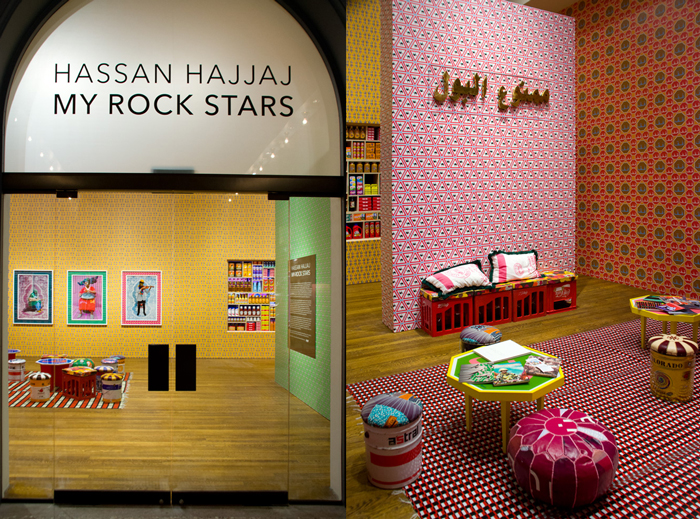 Hassan Hajjaj was born in Larache, Morocco and moved to London as a youth. As an artist, his style not only reflects a distinctly modern marriage of western and Middle Eastern aesthetics, but also draws on a unique interdisciplinary practice that involves photography, design, fashion and film. Hajjaj's work can be found in the permanent collections of the Brooklyn Museum and the British Museum, and his debut feature-length film, Karima: A Day in the Life of a Henna Girl, recently premiered at the Los Angeles County Museum of Art. Yet while one can certainly get a sense of Hajjaj's truly unique set of artistic principles through his individual works, his art is best experienced in the fully-immersive manner it's presented at the Worcester Art Museum.
Hassan Hajjaj was born in Larache, Morocco and moved to London as a youth. As an artist, his style not only reflects a distinctly modern marriage of western and Middle Eastern aesthetics, but also draws on a unique interdisciplinary practice that involves photography, design, fashion and film. Hajjaj's work can be found in the permanent collections of the Brooklyn Museum and the British Museum, and his debut feature-length film, Karima: A Day in the Life of a Henna Girl, recently premiered at the Los Angeles County Museum of Art. Yet while one can certainly get a sense of Hajjaj's truly unique set of artistic principles through his individual works, his art is best experienced in the fully-immersive manner it's presented at the Worcester Art Museum.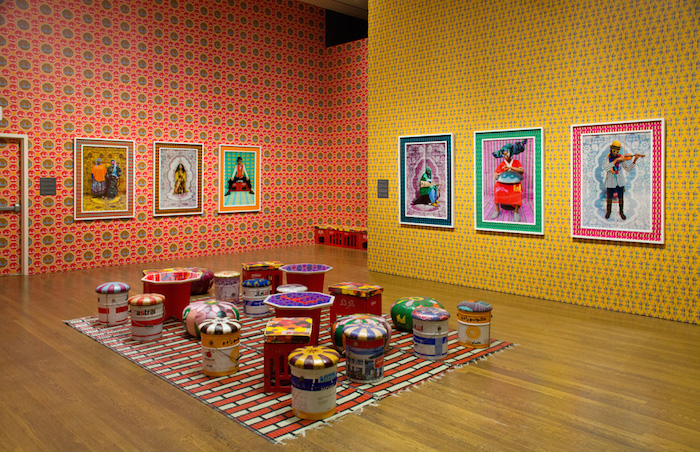 Entering the installation, which was organized by the Newark Museum, visitors are immediately greeted by portraits of Hajjaj's nine titular "rock stars" on separate large-scale metallic lambda prints on white dibond, each serving as a personal tribute to a specific favorite musician of Hajjaj's. They hail from South Africa, Burkina Faso, Morocco, Jamaica, Venezuela, USA, Brazil, Nigeria and London, with each portrait lined with handcrafted frames featuring goods sourced in Moroccan markets.
Entering the installation, which was organized by the Newark Museum, visitors are immediately greeted by portraits of Hajjaj's nine titular "rock stars" on separate large-scale metallic lambda prints on white dibond, each serving as a personal tribute to a specific favorite musician of Hajjaj's. They hail from South Africa, Burkina Faso, Morocco, Jamaica, Venezuela, USA, Brazil, Nigeria and London, with each portrait lined with handcrafted frames featuring goods sourced in Moroccan markets.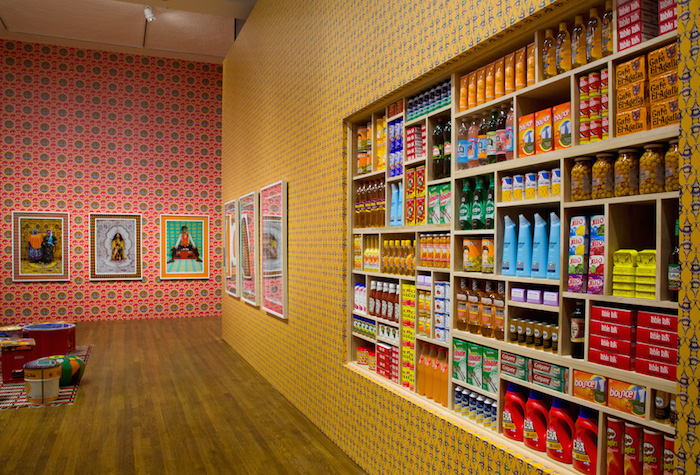 Clockwise, there's a recessed shelving unit displaying a mind-boggling variety of international household and food products, such as six-pound cans of La Morena Nacho Slices, “sour orange juice,” two-pound packages of ketchup, cans of condensed milk and Dr. Bronner's All-In-One Hemp Lavender Soap. There are both unfamiliar and familiar labels, from generic lemon-fresh dishwasher detergent, different flavors of packaged Jell-O, toothpaste, fabric softener, and packaged sardines, to baby shampoo, Pringles, Ultraclean Listerine and antibacterial toilet cleaner. Industrial-sized jars of peanut butter are nestled among one-pound tins of Flurecitas candies from Puerto Rico, Inca's Food Yellow Hot Pepper Whole in Brine from Peru, Table Talk Old Fashion Pies, Café Bustelo, packages of Zwan's Chicken and Beef Luncheon Loaf, cans of Barbasol, and unidentified bottles of something that could either be a type of cleaning product or a soft drink—only those read Cyrillic can say for sure.
Clockwise, there's a recessed shelving unit displaying a mind-boggling variety of international household and food products, such as six-pound cans of La Morena Nacho Slices, “sour orange juice,” two-pound packages of ketchup, cans of condensed milk and Dr. Bronner's All-In-One Hemp Lavender Soap. There are both unfamiliar and familiar labels, from generic lemon-fresh dishwasher detergent, different flavors of packaged Jell-O, toothpaste, fabric softener, and packaged sardines, to baby shampoo, Pringles, Ultraclean Listerine and antibacterial toilet cleaner. Industrial-sized jars of peanut butter are nestled among one-pound tins of Flurecitas candies from Puerto Rico, Inca's Food Yellow Hot Pepper Whole in Brine from Peru, Table Talk Old Fashion Pies, Café Bustelo, packages of Zwan's Chicken and Beef Luncheon Loaf, cans of Barbasol, and unidentified bottles of something that could either be a type of cleaning product or a soft drink—only those read Cyrillic can say for sure.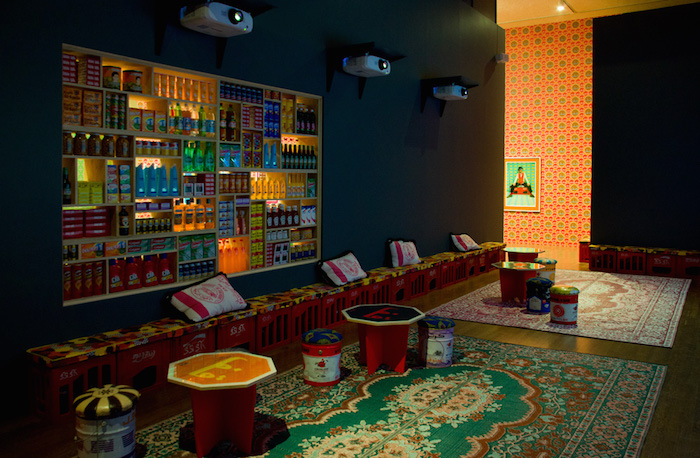 There's colorful wallpaper adorned with Arabic writing and camels, and a space that resembles a Moroccan tea room or hookah den. It can only be described as a "coloring parlor," with coloring pencils and black-and-white sheets depicting a dog in the role of a Classical Greek, a drummer, a violinist, etc. Here, visitors are encouraged to relax and color on stools made from large paint buckets topped off with cushions which are themselves repurposed from commercial fabrics, as well as fashioned from the more traditional leather. A woven black, white, and red large plastic mat lies beneath the octagonal tables for coloring. Along the perimeter are red plastic crates with the Coca-Cola logo spelled out in Arabic, decorated with colorful, Louis Vuitton-esque cushions and more repurposed fabric pillows.
There's colorful wallpaper adorned with Arabic writing and camels, and a space that resembles a Moroccan tea room or hookah den. It can only be described as a "coloring parlor," with coloring pencils and black-and-white sheets depicting a dog in the role of a Classical Greek, a drummer, a violinist, etc. Here, visitors are encouraged to relax and color on stools made from large paint buckets topped off with cushions which are themselves repurposed from commercial fabrics, as well as fashioned from the more traditional leather. A woven black, white, and red large plastic mat lies beneath the octagonal tables for coloring. Along the perimeter are red plastic crates with the Coca-Cola logo spelled out in Arabic, decorated with colorful, Louis Vuitton-esque cushions and more repurposed fabric pillows. The whole thing is set to a soundtrack of world music, its mysterious source revealed to the viewer only after leaving the coloring room. Behind the recessed shelving unit of artfully placed products, there's another room with dimmed lights where the aforementioned "rock stars" perform for each other (and the audience) in a 2012 video called My Rock Stars Experimental, Volume I. Hajjaj designed the costumes using traditional fabrics from Africa as well as luxury labels.In the end, just like Hajjaj and his art, the installation and the nine "rock stars," both collectively and as a whole, represent the necessity of maintaining the integrity of one's own culture. It also brings home the idea of the so-called global village while also suggesting that specific goods that are endemic to different regions remain perennial, despite (and perhaps, because of) rapid globalization.Hassan Hajjaj: My Rock Stars is on view through March 6, 2016 at Worcester Art Museum.
The whole thing is set to a soundtrack of world music, its mysterious source revealed to the viewer only after leaving the coloring room. Behind the recessed shelving unit of artfully placed products, there's another room with dimmed lights where the aforementioned "rock stars" perform for each other (and the audience) in a 2012 video called My Rock Stars Experimental, Volume I. Hajjaj designed the costumes using traditional fabrics from Africa as well as luxury labels.In the end, just like Hajjaj and his art, the installation and the nine "rock stars," both collectively and as a whole, represent the necessity of maintaining the integrity of one's own culture. It also brings home the idea of the so-called global village while also suggesting that specific goods that are endemic to different regions remain perennial, despite (and perhaps, because of) rapid globalization.Hassan Hajjaj: My Rock Stars is on view through March 6, 2016 at Worcester Art Museum.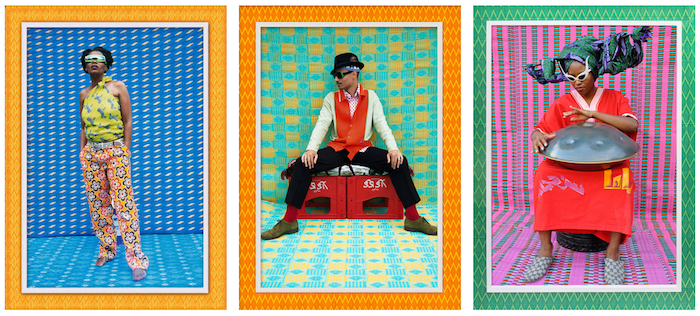
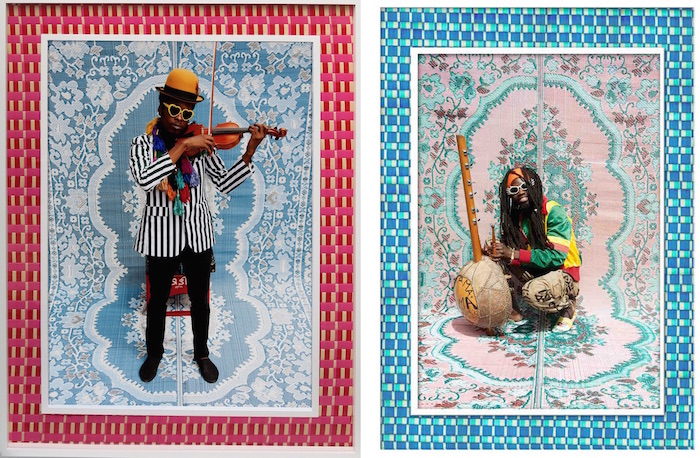 For more information about Hassan Hajjaj, click here.Related:The Arab World's 'Sesame Street' Returns for the First Time Since the Gulf WarGenerative "Magic Carpets" Make Their Final Stop in MoroccoBest Of The Rest: Artistic Gas Stations, Cat Heaven, And Scorpion Lollipops
For more information about Hassan Hajjaj, click here.Related:The Arab World's 'Sesame Street' Returns for the First Time Since the Gulf WarGenerative "Magic Carpets" Make Their Final Stop in MoroccoBest Of The Rest: Artistic Gas Stations, Cat Heaven, And Scorpion Lollipops
Advertisement
Advertisement
Advertisement
